Python采集游记攻略,为十月假期做准备
Posted python可乐编程
tags:
篇首语:本文由小常识网(cha138.com)小编为大家整理,主要介绍了Python采集游记攻略,为十月假期做准备相关的知识,希望对你有一定的参考价值。
用python爬取去哪儿游记攻略为十月假期做准备。。。爬虫之路,永无止境!
热热闹闹的开学季又来了,小伙伴们又可以在一起玩耍了,不对是在一起学习了,哈哈。

再过几周就是国庆假期,想想还是很激动的,我决定给大家做个游记爬虫,大家早做准备。。嘿嘿
很多人学习python,不知道从何学起。 很多人学习python,掌握了基本语法过后,不知道在哪里寻找案例上手。 很多已经做案例的人,却不知道如何去学习更加高深的知识。 那么针对这三类人,我给大家提供一个好的学习平台,免费领取视频教程,电子书籍,以及课程的源代码! QQ群:701698587 欢迎加入,一起讨论 一起学习!

代码操作展示:
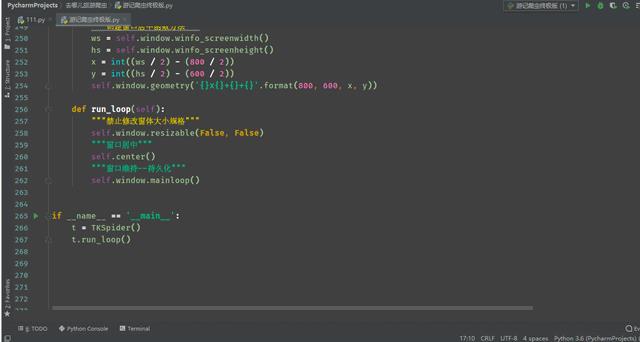
今天目标地址:
https://travel.qunar.com/place/
开发环境:
windows10
python3.6
开发工具:
pycharm
库:
tkinter、re、os、lxml、threading、xlwt、xlrd
1.首先先将全国所有的城市名称和id拿到
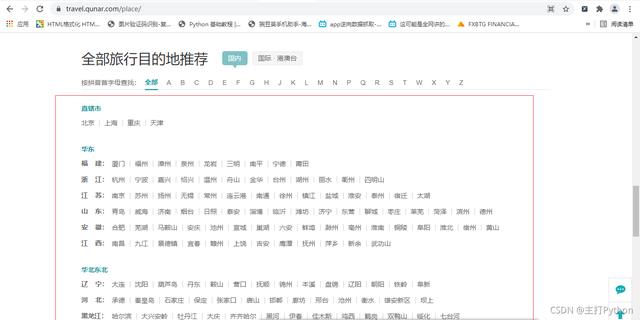
2.右击检查,进行抓包,找到数据所在的包
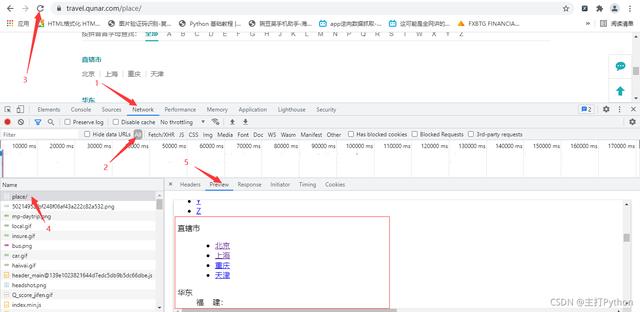
3.发送请求,获取响应,解析响应
# 发送请求,获取响应,解析响应 response = session.get(self.start_url, headers=self.headers).html # 提取所有目的地(城市)的url city_url_list = response.xpath( \'//*[@id="js_destination_recommend"]/div[2]/div[1]/div[2]/dl/dd/div/ul/li/a/@href\') city_id_list = [\'\'.join(re.findall(r\'-cs(.*?)-\', i)) for i in city_url_list] # 提取所有的城市名称 city_name_list = response.xpath( \'//*[@id="js_destination_recommend"]/div[2]/div[1]/div[2]/dl/dd/div/ul/li/a/text()\')
4.随机点一个城市,进入该城市,查看游记攻略,本文选的是上海
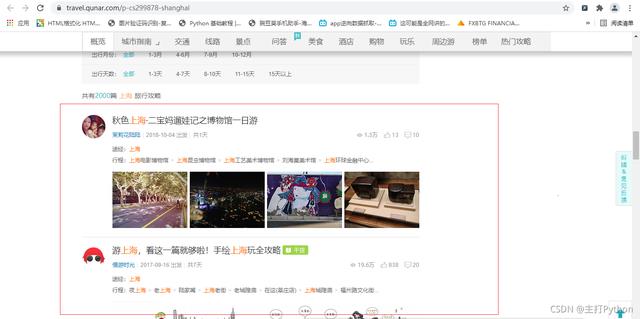
5.进行抓包,查找需要的信息
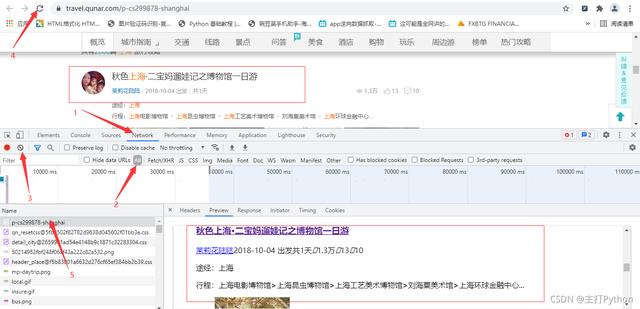
# 提取游记作者 author_list = html.xpath(\'//span[@class="user_name"]/a/text()\') # 出发时间 date_list = html.xpath(\'//span[@class="date"]/text()\') # 游玩时间 days_list = html.xpath(\'//span[@class="days"]/text()\') # 阅读量 read_list = html.xpath(\'//span[@class="icon_view"]/span/text()\') # 点赞量 like_count_list = html.xpath(\'//span[@class="icon_love"]/span/text()\') # 评论量 icon_list = html.xpath(\'//span[@class="icon_comment"]/span/text()\') # 游记地址 text_url_list = html.xpath(\'//h3[@class="tit"]/a/@href\')
6.进行翻页抓包,第二页为异步加载

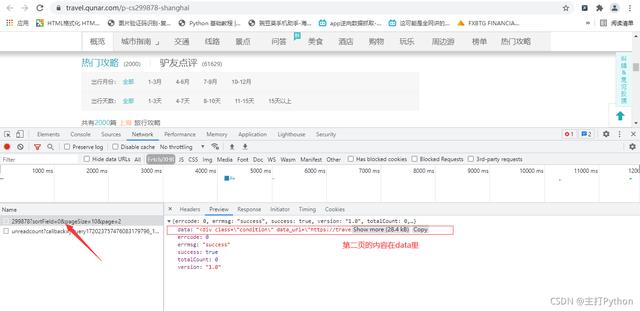
7.在上一张图中点击Headers,获取游记攻略的请求地址
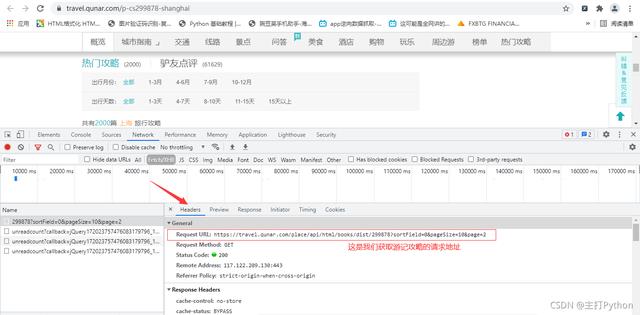
这样思路是不是清晰一点,来观察一下请求地址
https://travel.qunar.com/place/api/html/books/dist/299878?sortField=0&pageSize=10&page=2
其中299878是上海城市的id page是页数
源码展示:
# !/usr/bin/nev python # -*-coding:utf8-*- import tkinter as tk import re from lxml import etree import tkinter.messagebox as msgbox from requests_html import HTMLSession from threading import Thread import os, xlwt, xlrd from xlutils.copy import copy session = HTMLSession() class TKSpider(object): def __init__(self): # 定义循环条件 self.is_running = True # 定义起始的页码 self.start_page = 1 """定义可视化窗口,并设置窗口和主题大小布局""" self.window = tk.Tk() self.window.title(\'爬虫数据采集\') self.window.geometry(\'1000x800\') """创建label_user按钮,与说明书""" self.label_user = tk.Label(self.window, text=\'请选择城市输入序号:\', font=(\'Arial\', 12), width=30, height=2) self.label_user.pack() """创建label_user关联输入""" self.entry_user = tk.Entry(self.window, show=None, font=(\'Arial\', 14)) self.entry_user.pack(after=self.label_user) """创建Text富文本框,用于按钮操作结果的展示""" # 定义富文本框滑动条 scroll = tk.Scrollbar() # 放到窗口的右侧, 填充Y竖直方向 scroll.pack(side=tk.RIGHT, fill=tk.Y) self.text1 = tk.Text(self.window, font=(\'Arial\', 12), width=75, height=20) self.text1.pack() # 两个控件关联 scroll.config(command=self.text1.yview) self.text1.config(yscrollcommand=scroll.set) """定义按钮1,绑定触发事件方法""" self.button_1 = tk.Button(self.window, text=\'下载游记\', font=(\'Arial\', 12), width=10, height=1, command=self.parse_hit_click_1) self.button_1.pack(before=self.text1) """定义按钮2,绑定触发事件方法""" self.button_2 = tk.Button(self.window, text=\'清除\', font=(\'Arial\', 12), width=10, height=1, command=self.parse_hit_click_2) self.button_2.pack(anchor="e") """定义富文本文字的显示""" self.start_url = \'https://travel.qunar.com/place/\' self.headers = { \'user-agent\': \'Mozilla/5.0 (Windows NT 10.0; Win64; x64) AppleWebKit/537.36 (KHTML, like Gecko) Chrome/92.0.4515.159 Safari/537.36\' } # 发送请求,获取响应,解析响应 response = session.get(self.start_url, headers=self.headers).html # 提取所有目的地(城市)的url city_url_list = response.xpath( \'//*[@id="js_destination_recommend"]/div[2]/div[1]/div[2]/dl/dd/div/ul/li/a/@href\') city_id_list = [\'\'.join(re.findall(r\'-cs(.*?)-\', i)) for i in city_url_list] # 提取所有的城市名称 city_name_list = response.xpath( \'//*[@id="js_destination_recommend"]/div[2]/div[1]/div[2]/dl/dd/div/ul/li/a/text()\') self.dict_data = dict(zip(city_id_list, city_name_list)) text_info = \'\' for city_id, city_name in zip(city_id_list, city_name_list): text_info += city_id + ":" + city_name + \'\\t\\t\' self.text1.insert("insert", text_info) def parse_hit_click_1(self): """线程关联:定义触发事件1, 将执行结果显示在文本框中""" Thread(target=self.parse_start_url_job).start() def parse_city_id_name_info(self): """ 富文本内容展示: :return: """ # 发送请求,获取响应,解析响应 response = session.get(self.start_url, headers=self.headers).html # 提取所有目的地(城市)的url city_url_list = response.xpath( \'//*[@id="js_destination_recommend"]/div[2]/div[1]/div[2]/dl/dd/div/ul/li/a/@href\') city_id_list = [\'\'.join(re.findall(r\'-cs(.*?)-\', i)) for i in city_url_list] # 提取所有的城市名称 city_name_list = response.xpath( \'//*[@id="js_destination_recommend"]/div[2]/div[1]/div[2]/dl/dd/div/ul/li/a/text()\') self.dict_data = dict(zip(city_id_list, city_name_list)) text_info = \'\' for city_id, city_name in zip(city_id_list, city_name_list): text_info += city_id + ":" + city_name + \'\\t\\t****\' self.text1.insert("insert", text_info) def parse_start_url_job(self): # 从输入窗口获取输入 city_id = self.entry_user.get() self.text1.delete("1.0", "end") # 异常捕捉,是否存在key值 try: city_name = self.dict_data[city_id] self.parse_request_yj(city_id, city_name) except: # 报错提示 msgbox.showerror(title=\'错误\', message=\'检测到瞎搞,请重新输入!\') def parse_request_yj(self, city_id, city_name): """ 拼接游记地址,进行翻页 :param city_id: 城市的id :param city_name: 城市的名称 :return: """ while self.is_running: yj_url = f\'https://travel.qunar.com/place/api/html/books/dist/{city_id}?sortField=0&pageSize=10&page={self.start_page}\' response = session.get(yj_url, headers=self.headers).json()[\'data\'].replace(\'\\\\\', \'\') html = etree.HTML(response) # 提取游记的标题: title_list = html.xpath(\'//h3[@class="tit"]/a/text()\') # 死循环的终止条件 if not title_list: print("该城市已经采集到最后一页----------城市切换中---------logging!!!") break else: # 提取游记作者 author_list = html.xpath(\'//span[@class="user_name"]/a/text()\') # 出发时间 date_list = html.xpath(\'//span[@class="date"]/text()\') # 游玩时间 days_list = html.xpath(\'//span[@class="days"]/text()\') # 阅读量 read_list = html.xpath(\'//span[@class="icon_view"]/span/text()\') # 点赞量 like_count_list = html.xpath(\'//span[@class="icon_love"]/span/text()\') # 评论量 icon_list = html.xpath(\'//span[@class="icon_comment"]/span/text()\') # 游记地址 text_url_list = html.xpath(\'//h3[@class="tit"]/a/@href\') """构造保存数据格式字典""" for a, b, c, d, e, f, g, h in zip(title_list, author_list, date_list, days_list, read_list, like_count_list, icon_list, text_url_list): dict_dd = { city_name: [a, b, c, d, e, f, g, h] } self.text1.insert("insert", f"{a}-----------采集完成!!!" + \'\\n\') self.SaveExcels(dict_dd) self.start_page += 1 def SaveExcels(self, data): # 获取表的名称 sheet_name = [i for i in data.keys()][0] # 创建保存excel表格的文件夹 # os.getcwd() 获取当前文件路径 os_mkdir_path = os.getcwd() + \'/数据/\' # 判断这个路径是否存在,不存在就创建 if not os.path.exists(os_mkdir_path): os.mkdir(os_mkdir_path) # 判断excel表格是否存在 工作簿文件名称 os_excel_path = os_mkdir_path + \'数据.xls\' if not os.path.exists(os_excel_path): # 不存在,创建工作簿(也就是创建excel表格) workbook = xlwt.Workbook(encoding=\'utf-8\') """工作簿中创建新的sheet表""" # 设置表名 worksheet1 = workbook.add_sheet(sheet_name, cell_overwrite_ok=True) """设置sheet表的表头""" sheet1_headers = (\'游记标题\', \'发布游记的作者名称\', \'出发时间\', \'游玩时间\', \'阅读量\', \'点赞量\', \'评论量\', \'游记地址\') # 将表头写入工作簿 for header_num in range(0, len(sheet1_headers)): # 设置表格长度 worksheet1.col(header_num).width = 2560 * 3 # 写入表头 行, 列, 内容 worksheet1.write(0, header_num, sheet1_headers[header_num]) # 循环结束,代表表头写入完成,保存工作簿 workbook.save(os_excel_path) """=============================已有工作簿添加新表===============================================""" # 打开工作薄 workbook = xlrd.open_workbook(os_excel_path) # 获取工作薄中所有表的名称 sheets_list = workbook.sheet_names() # 如果表名称:字典的key值不在工作簿的表名列表中 if sheet_name not in sheets_list: # 复制先有工作簿对象 work = copy(workbook) # 通过复制过来的工作簿对象,创建新表 -- 保留原有表结构 sh = work.add_sheet(sheet_name) # 给新表设置表头 excel_headers_tuple = (\'游记标题\', \'发布游记的作者名称\', \'出发时间\', \'游玩时间\', \'阅读量\', \'点赞量\', \'评论量\', \'游记地址\') for head_num in range(0, len(excel_headers_tuple)): sh.col(head_num).width = 2560 * 3 # 行,列, 内容, 样式 sh.write(0, head_num, excel_headers_tuple[head_num]) work.save(os_excel_path) """=========================================================================================""" # 判断工作簿是否存在 if os.path.exists(os_excel_path): # 打开工作簿 workbook = xlrd.open_workbook(os_excel_path) # 获取工作薄中所有表的个数 sheets = workbook.sheet_names() for i in range(len(sheets)): for name in data.keys(): worksheet = workbook.sheet_by_name(sheets[i]) # 获取工作薄中所有表中的表名与数据名对比 if worksheet.name == name: # 获取表中已存在的行数 rows_old = worksheet.nrows # 将xlrd对象拷贝转化为xlwt对象 new_workbook = copy(workbook) # 获取转化后的工作薄中的第i张表 new_worksheet = new_workbook.get_sheet(i) for num in range(0, len(data[name])): new_worksheet.write(rows_old, num, data[name][num]) new_workbook.save(os_excel_path) def parse_hit_click_2(self): """定义触发事件2,删除文本框中内容""" self.entry_user.delete(0, "end") # self.entry_passwd.delete(0, "end") self.text1.delete("1.0", "end") self.parse_city_id_name_info() def center(self): """创建窗口居中函数方法""" ws = self.window.winfo_screenwidth() hs = self.window.winfo_screenheight() x = int((ws / 2) - (800 / 2)) y = int((hs / 2) - (600 / 2)) self.window.geometry(\'{}x{}+{}+{}\'.format(800, 600, x, y)) def run_loop(self): """禁止修改窗体大小规格""" self.window.resizable(False, False) """窗口居中""" self.center() """窗口维持--持久化""" self.window.mainloop() if __name__ == \'__main__\': t = TKSpider() t.run_loop()
以上是关于Python采集游记攻略,为十月假期做准备的主要内容,如果未能解决你的问题,请参考以下文章